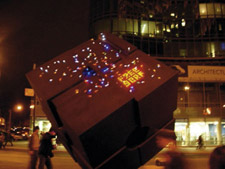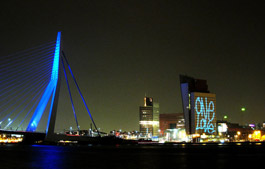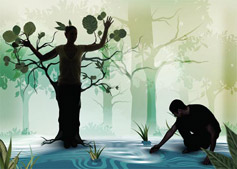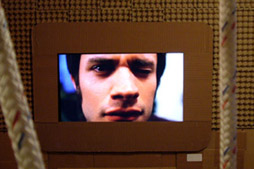The Graffiti Research Lab, is a New York based art group with a technical twist. The GRL was founded in 2005 at Eyebeam Openlab where Evan Roth and James Powderly were both doing fellowships when they met and teamed up. Both of the founders have strong technological backgrounds so it came as no surprise that they would use those skills in their creations.
The team works on new technological ways for people to express themselves through graffiti. Their best known products include the LED throwies which are little LED lightbulbs with a magnet that can be thrown on to any metallic surface to either decorate or get a message accross and the Laser tag which involved using a prjocetor and a technology they developed with Theodore Watson , where they had made a program that imitated the leaking patterns of real graffiti and were able to paint on big houses with a laser. The Laser tag had no long term effects so it was not hard to get a permit for making it when they first did it in Rotterdam and has since been recreated in various ways and always attracted an active, interested crowd.
Theodore Watson, who programmed the Laser tag I found especially interesting. He is a british artist with a very strong focus on technology and programing and is currently residing in Amsterdam.
Watson has a BA in Fine Arts and Design and Technology from Parsons and has had his work displayed at various high profile museums and art fairs such as the MoMa, Tate Modern, Sundance and so on and so forth.
Most recently Watson has been working with children, he designed with visual and motion graphics designer Emily Gobeille, an interactive forest program for children, called Funky forest. The project was premiered in 2007 at the Cinekid festival in Amsterdam. The installation lives and moves with the visitors, by pressing your body against the forest creates a new tree in your shape with different characteristics, by diverting streams of water flowing on the floor different parts if the forest grow, if a tree doesn’t get water it dies. The health of the trees in the forest controls the inhabiting creatures. The installation shows children how nature works in delicate ecosystems.
My favorite work by Watson is his work for a Michel Gondry exhibition. Watson made interactive installations around Michel’s new film at the time, The science of sleep. He made a cardboard covered, kitchen like room with built in screens and paper covered interactive cameras. In one part of the room you could stand facing a screen and pull strings to control the face of Gael García Bernal, in another you could move a camera and see parts of the room with strange effects. A special room with big windows that displayed scenes from the film as fake reality with moving lights and finally a video-piano. The piano had videos and sounds recorded and displayed them when the piano was played. http://muonics.net/
posting by Sunna Sigurmarsdottir





